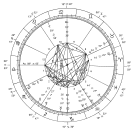Taurus (astrology)
| Taurus | |
|---|---|
 | |
|
| |
| Zodiac symbol | Bull |
| Duration (tropical, western) | April 19 – May 20 (2016, UT1)[1] |
| Constellation | Taurus |
| Zodiac element | Earth |
| Zodiac quality | Fixed |
| Sign ruler | Venus, Earth |
| Detriment | Mars (ancient), Pluto (modern) |
| Exaltation | Moon |
| Fall | Uranus |
|
| |
| Astrology |
|---|
 New millennium astrological chart |
| Background |
| Traditions |
| Branches |
|
|
Taurus (Latin for "the Bull"; symbol: ![]() , Unicode: ♉) is the second astrological sign in the present zodiac. It spans the 30–60th degree of the zodiac. The Sun is in the sign of Taurus from about April 21 until about May 21[2] (Western astrology) or from about May 16 to June 16 [3] (Sidereal astrology). People born between these dates, depending on which system of astrology they subscribe to, may be called Taureans.[4][2] The symbol of the bull is based on the Cretan Bull, the white bull that fathered the Minotaur who was killed by Theseus.[5]
, Unicode: ♉) is the second astrological sign in the present zodiac. It spans the 30–60th degree of the zodiac. The Sun is in the sign of Taurus from about April 21 until about May 21[2] (Western astrology) or from about May 16 to June 16 [3] (Sidereal astrology). People born between these dates, depending on which system of astrology they subscribe to, may be called Taureans.[4][2] The symbol of the bull is based on the Cretan Bull, the white bull that fathered the Minotaur who was killed by Theseus.[5]
History
Taurus was the second sign of the zodiac established among the ancient Mesopotamians – who knew it as the Bull of Heaven – because it was the constellation through which the sun rose on the vernal equinox at that time. Due to the precession of the equinox, it has since passed through the constellation Aries and into the constellation Pisces (hence our current era being known as the Age of Pisces). The Bull represents a strong-willed character with great perseverance and determination. In Egypt, Taurus was seen as the cow goddess Hathor. Hathor was the goddess of beauty, love, and happiness, and she represented all of the riches seen in cattle as the providers of nourishment. Roman astrologers considered Taurus ruled by Venus, the goddess of beauty, and Earth.
Notes
Works cited
- Astronomical Applications Department (2011). Multiyear Computer Interactive Almanac. 2.2.2. Washington DC: US Naval Observatory. Longitude of Sun, apparent geocentric ecliptic of date, interpolated to find time of crossing 0°, 30°....
- Atsma, Aaron J (2016). "CRETAN BULL : Bull of Crete, labour Heracles ; Greek mythology ; pictures ; constellation Taurus : TAUROS KRETAIOS". Theoi. Retrieved September 23, 2016.
- Indian Astrology 2000 (2016). "Learn About Taurus Horoscope - Love Compatibility - Personality". Retrieved September 23, 2016.
- Shapiro, Lee (1977). "The Real Constellations of the Zodiac". Retrieved May 16, 2016.
- Swift, Jackson (2015). "Astrology: Tropical Zodiac and Sidereal Zodiac". Archived from the original on November 18, 2015. Retrieved September 23, 2016.
- Oxford Dictionaries. "Taurus, Gemini - definitions of Taurus and Gemini in English from the Oxford dictionary".